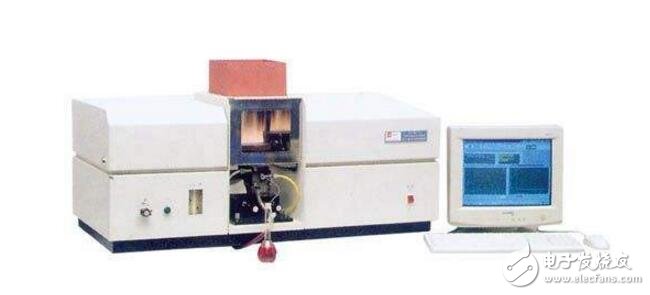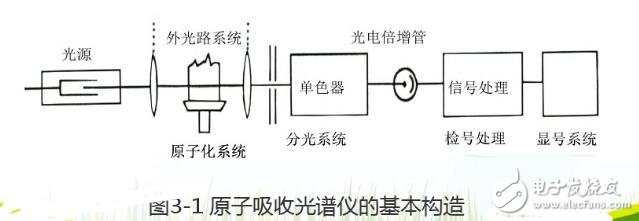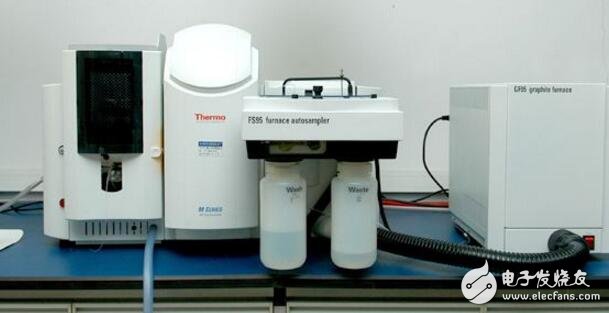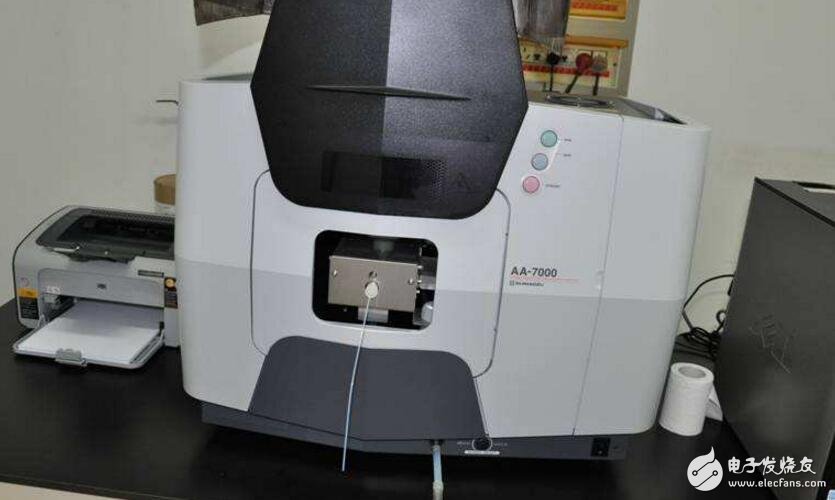Principle and composition of atomic absorption spectrophotometer_Atomic absorption spectrophotometer application
Atomic absorption spectrometer, also known as atomic absorption spectrophotometer, performs metal element analysis based on the effect of the atomic vapor of the ground state on the characteristic radiation absorption. It is capable of sensitively and reliably measuring trace or trace elements.

The atomic absorption spectrophotometer is mainly composed of a light source, an atomizer, a spectroscopic system and a detection system. There are two main types of atomizers, flame atomizers and electrothermal atomizers. Flames have a variety of flames, and air-acetylene flames are currently commonly used. Electrothermal atomizers are commonly used in graphite furnace atomizers, and thus atomic absorption spectrophotometers have a flame atomic absorption spectrophotometer and an atomic absorption spectrophotometer with a graphite furnace.
(1) The role of the light source is to supply a sufficiently sharp resonance line required for atomic absorption.
(2) The role of the atomizer is to provide a certain amount of energy to free the sample from the ground state atoms that can function in the atomic absorption and to enter the absorption path of the atomic absorption spectrum lamp.
(3) The function of the spectroscopic system is to separate the absorption line to be measured from other lines, thereby obtaining a sharp resonance line required for atomic absorption.
(4) The detection system includes optoelectronic components, amplifiers, and reading systems.

The advantage of the flame atomization method is that the flame atomization method is simple in operation, good in reproducibility, large in effective optical path, and highly sensitive to most elements, so it is widely used. The disadvantages are: low atomization efficiency, high sensitivity, and generally cannot directly analyze solid samples;
The graphite furnace atomizer has the advantages of high atomization efficiency, high sample utilization rate at an adjustable high temperature, high sensitivity, and low sample dosage, which is suitable for the determination of refractory elements. The disadvantages are: the influence of the composition non-uniformity is large, the precision of the measurement is low, the interference of the coexisting compound is larger than the flame atomization method, and the interference background is serious, and the background is generally required to be corrected.

The element is heated and atomized in a pyrolytic graphite furnace to become a ground state atomic vapor, which selectively absorbs the characteristic radiation emitted by the hollow cathode lamp. In a certain concentration range, the absorption intensity is proportional to the content of the measured element in the test solution. The quantitative relationship can be obtained by Lange-Beier's law, A= -lg I/I o= -lgT = KCL, where I is the transmitted light intensity; I0 is the emitted light intensity; T is the transmittance; L is the light passing atomization The optical path (length), the L value of each instrument is fixed; C is the measured sample concentration; so A = KC.
A device that uses the resonance radiation of an element to be tested and whose absorbance is measured by its atomic vapor is called an atomic absorption spectrophotometer. It has single-beam, double-beam, double-channel, multi-channel and other structural forms. Its basic structure includes a light source, an atomizer, an optical system, and a detection system. It is mainly used for the analysis of trace element impurities, and has two main advantages: high sensitivity and good selectivity. Widely used in the analysis of trace elements in various gases, metal organic compounds, metal alkoxides. However, the determination of each element requires a corresponding hollow cathode lamp, which is inconvenient for the inspection work.

Atomic absorption can be used as an experimental means of physical and physical chemistry to determine and study some of the basic properties of a substance. Electrothermal atomizers are easy to control the evaporation process and the atomization process, so there are many advantages to using it to determine some basic parameters. Some of the activation energy, elemental diffusion coefficient, dissociation energy, vibrator strength, broadening of the spectral line profile, solubility, vapor pressure, etc. of the elements leaving the body measured by the electrothermal atomizer.
2. Application in elemental analysisAtomic absorption spectrometry, due to its high sensitivity, low interference, simple and rapid analysis method, is widely used in various fields such as industry, agriculture, biochemistry, geology, metallurgy, food, environmental protection, etc. At present, atomic absorption enthalpy becomes a metal element analysis. One of the powerful tools, and in many areas as a standard analytical method. The characteristics of atomic absorption spectrometry determine its important position in geological and metallurgical analysis. It not only replaces many common wet chemical analyses, but also has the same status as X-ray fluorescence analysis and even neutron activation analysis. . At present, the atomic absorption method is used to determine more than 70 elements in geological samples, and most of them can achieve sufficient sensitivity and good precision. Analysis of various trace elements in steel, alloys and high-purity metals is now also mostly done by atomic absorption. Atomic absorption is becoming more widespread in food analysis. More than 20 elements in foods and beverages have satisfactory methods of atomic absorption analysis. Analysis of essential and hazardous elements in biochemical and clinical samples is now performed using atomic absorption. Literature reports on atomic absorption analysis of metal elements in petroleum products, ceramics, agricultural samples, pharmaceuticals and coatings have been increasing in recent years. Analysis of trace metal elements in environmental samples such as water and atmosphere has become one of the important areas of atomic absorption analysis. Certain non-metallic elements can be determined by indirect atomic absorption.
3. Application in organic matter analysisA variety of organics can be determined by indirect methods. 8-hydroxyquinoline (Cu), alcohol (Cr), aldehyde (Ag), ester (Fe), phenol (Fe), biacetyl (Ni), citric acid (Cu), fatty amine (co) , amino acid (Cu), vitamin C (Ni), anthranilic acid (Co), remi seal (Cu), quinine formic acid (Zn), organic anhydride (Fe), benzylpenicillin (Cu), glucose (Ca ), various organic substances such as epoxide hydrolase (PbO, halogen-containing organic compound (Ag)) are indirectly determined by stoichiometric reaction with the corresponding metal element.
4. Application in metal chemical speciation analysisDifferent organic compounds of the same metal element can be analyzed by separation by gas chromatography and liquid chromatography and then by atomic absorption spectroscopy. For example, five kinds of alkyl lead in gasoline, five kinds of alkyl lead in the atmosphere, alkyl selenium, alkyl hydrazine, alkyl tin, alkyl hydrazine in water, alkyl lead, alkyl group, alkyl mercury, organic Chromium, various metal organic compounds such as alkyl lead, alkyl mercury, organic zinc, and organic copper in the organism can be identified and determined by different types of spectral atomic absorption.
USB charger, USB Adaptor, Charging USB Ports, USB quick charger
NINGBO COWELL ELECTRONICS & TECHNOLOGY CO., LTD , https://www.cowellsocket.com